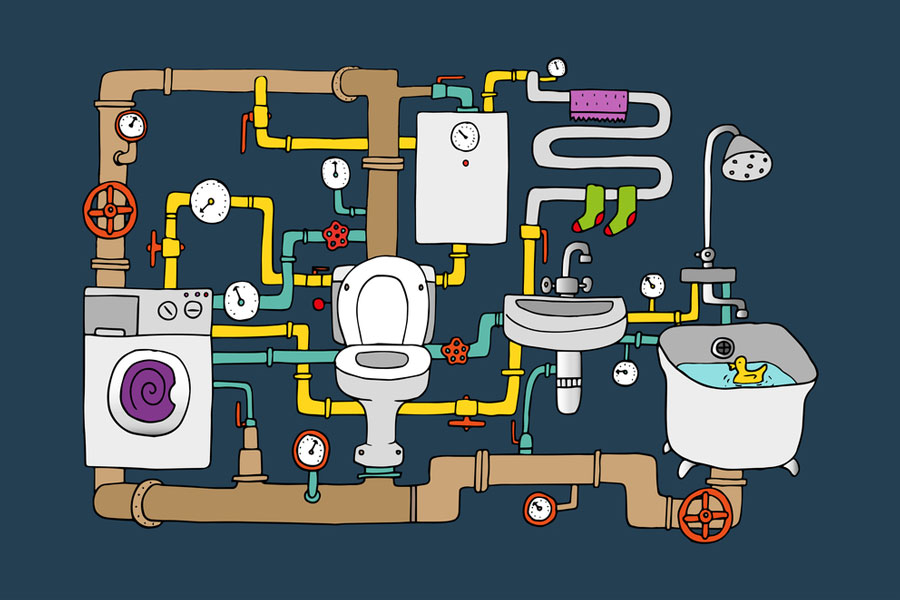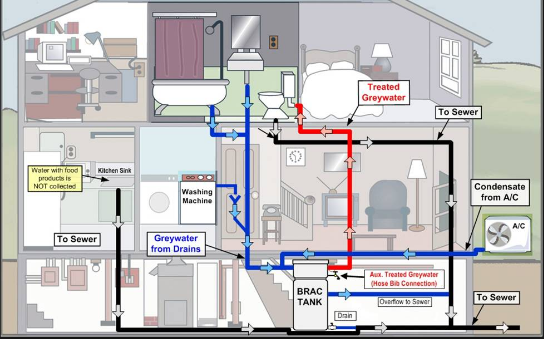They are making a number of good annotation relating to Plumbing Installation 101: All You Need to Know as a whole in this content following next.

Comprehending how your home's plumbing system works is essential for every house owner. From providing clean water for drinking, food preparation, and showering to safely getting rid of wastewater, a properly maintained plumbing system is essential for your household's health and wellness and comfort. In this detailed guide, we'll explore the intricate network that composes your home's pipes and offer pointers on upkeep, upgrades, and managing typical issues.
Introduction
Your home's pipes system is greater than simply a network of pipelines; it's an intricate system that guarantees you have accessibility to tidy water and reliable wastewater elimination. Understanding its elements and how they interact can assist you stop expensive repair services and make sure every little thing runs smoothly.
Basic Components of a Plumbing System
Pipelines and Tubes
At the heart of your pipes system are the pipelines and tubing that carry water throughout your home. These can be constructed from numerous products such as copper, PVC, or PEX, each with its benefits in regards to toughness and cost-effectiveness.
Components: Sinks, Toilets, Showers, etc.
Fixtures like sinks, bathrooms, showers, and tubs are where water is used in your home. Recognizing just how these components link to the plumbing system aids in detecting issues and intending upgrades.
Shutoffs and Shut-off Points
Valves regulate the circulation of water in your plumbing system. Shut-off valves are critical during emergency situations or when you require to make repair work, allowing you to separate parts of the system without interrupting water flow to the whole house.
Water System
Key Water Line
The main water line attaches your home to the local supply of water or a private well. It's where water enters your home and is dispersed to different fixtures.
Water Meter and Pressure Regulator
The water meter procedures your water usage, while a stress regulatory authority ensures that water moves at a secure stress throughout your home's plumbing system, avoiding damage to pipelines and fixtures.
Cold Water vs. Warm water Lines
Comprehending the difference between cold water lines, which supply water straight from the major, and hot water lines, which carry warmed water from the water heater, aids in troubleshooting and preparing for upgrades.
Drain System
Drain Pipes Water Lines and Traps
Drain pipelines carry wastewater far from sinks, showers, and toilets to the drain or septic system. Catches stop sewer gases from entering your home and additionally trap particles that could cause blockages.
Ventilation Pipes
Air flow pipes permit air into the water drainage system, preventing suction that can reduce drainage and trigger catches to empty. Correct ventilation is necessary for maintaining the integrity of your pipes system.
Relevance of Proper Drain
Ensuring appropriate water drainage prevents backups and water damages. Regularly cleansing drains and preserving catches can prevent expensive repair work and expand the life of your plumbing system.
Water Heater
Sorts Of Water Heaters
Hot water heater can be tankless or typical tank-style. Tankless heaters warm water as needed, while tanks keep warmed water for instant usage.
Upgrading Your Plumbing System
Factors for Updating
Updating to water-efficient fixtures or replacing old pipes can boost water top quality, reduce water expenses, and boost the worth of your home.
Modern Plumbing Technologies and Their Benefits
Check out modern technologies like clever leak detectors, water-saving bathrooms, and energy-efficient hot water heater that can save cash and lower environmental effect.
Price Factors To Consider and ROI
Calculate the upfront expenses versus long-lasting financial savings when taking into consideration plumbing upgrades. Many upgrades spend for themselves via lowered energy bills and fewer repair work.
Exactly How Water Heaters Link to the Plumbing System
Understanding how water heaters link to both the cold water supply and hot water distribution lines assists in identifying problems like inadequate warm water or leaks.
Maintenance Tips for Water Heaters
Routinely flushing your water heater to eliminate debris, examining the temperature level settings, and inspecting for leaks can extend its lifespan and improve energy performance.
Usual Pipes Concerns
Leaks and Their Causes
Leaks can occur due to aging pipes, loosened installations, or high water stress. Attending to leakages immediately avoids water damage and mold development.
Obstructions and Clogs
Blockages in drains and commodes are commonly triggered by flushing non-flushable things or a build-up of oil and hair. Using drain displays and bearing in mind what decreases your drains can prevent obstructions.
Indications of Plumbing Problems to Look For
Low water stress, slow-moving drains, foul odors, or unusually high water costs are signs of possible pipes issues that should be resolved quickly.
Plumbing Upkeep Tips
Routine Inspections and Checks
Set up annual plumbing evaluations to capture problems early. Search for indications of leaks, corrosion, or mineral build-up in taps and showerheads.
DIY Upkeep Tasks
Easy tasks like cleansing faucet aerators, looking for bathroom leakages utilizing dye tablet computers, or insulating subjected pipes in chilly environments can prevent significant plumbing concerns.
When to Call an Expert Plumber
Know when a pipes issue calls for expert expertise. Attempting intricate repair work without appropriate expertise can cause even more damages and higher repair work expenses.
Tips for Reducing Water Use
Simple routines like fixing leakages without delay, taking shorter showers, and running complete loads of washing and dishes can save water and reduced your utility expenses.
Eco-Friendly Pipes Options
Take into consideration sustainable pipes products like bamboo for floor covering, which is durable and environmentally friendly, or recycled glass for kitchen counters.
Emergency situation Preparedness
Actions to Take Throughout a Pipes Emergency situation
Know where your shut-off valves lie and just how to turn off the supply of water in case of a ruptured pipeline or major leak.
Significance of Having Emergency Situation Contacts Useful
Maintain contact info for regional plumbers or emergency services conveniently offered for fast reaction throughout a pipes situation.
Environmental Impact and Conservation
Water-Saving Fixtures and Devices
Mounting low-flow faucets, showerheads, and bathrooms can substantially lower water usage without compromising efficiency.
Do It Yourself Emergency Situation Fixes (When Applicable).
Short-term repairs like making use of duct tape to spot a dripping pipeline or placing a bucket under a leaking faucet can lessen damages till a professional plumbing shows up.
Final thought.
Recognizing the makeup of your home's pipes system encourages you to maintain it effectively, conserving money and time on repairs. By following regular maintenance routines and staying educated concerning modern plumbing innovations, you can ensure your pipes system runs successfully for several years to find.
The Anatomy of Your Home s Plumbing System
Understanding the anatomy of your home s plumbing system is essential for any homeowner. It not only helps in identifying potential issues but also facilitates effective communication with professionals when repairs or upgrades are needed. Your home s plumbing system is more than just pipes and faucets; it s a complex network that ensures the efficient and hygienic flow of water in and out of your house. In this blog, we ll dissect the crucial components of your home s plumbing system. For those in Antelope Valley, Brock Plumbing is your trusted partner for all your plumbing needs, ensuring your system functions smoothly and efficiently.
Water Supply System
- Main Water Line: This is where your home s plumbing system begins. The main water line connects your home to the public water supply or a private well.
- Pipes and Shut-off Valves: Pipes distribute water throughout your home. Shut-off valves are crucial for controlling the flow of water and making repairs without shutting off the entire system.
Drainage System
- Drain Pipes: These pipes carry waste and water away from sinks, toilets, and showers.
- Vents: Vents allow sewer gases to escape and help maintain proper pressure in the drainage pipes, ensuring efficient flow of wastewater.
- Traps: Every fixture has a trap, a U-shaped pipe that holds water and prevents sewer gases from entering your home. The most common is the P-trap under sinks.
Fixtures and Appliances
Fixtures and appliances are the most interacted with parts of your plumbing system. They include sinks, toilets, showers, dishwashers, and washing machines. Each fixture and appliance has its own supply and drainage connection, ensuring they receive clean water and can dispose of wastewater effectively.
Water Heating System
Your water heater is a crucial component, providing hot water to various fixtures and appliances in your home. It can be tank-based or tankless, with each type having its own set of advantages and maintenance requirements. Regular maintenance is essential to ensure efficient operation and extend the lifespan of the unit.
Sump Pump
In areas prone to flooding or with high water tables, a sump pump is an essential part of the plumbing system. It s installed in the lowest part of your basement or crawlspace and pumps out water that accumulates, preventing flooding and protecting your home from water damage.
Septic System
Homes that are not connected to a municipal sewer system have a septic system and an underground wastewater treatment structure. Understanding how to maintain your septic system is crucial to prevent backups, odors, and early system failure.
Conclusion
Your home s plumbing system is a complex and essential network, ensuring the efficient and hygienic flow of water in and out of your property. Understanding its key components helps in maintaining it properly and identifying issues before they escalate into major problems. For residents in Antelope Valley, Brock Plumbing is dedicated to providing top-notch services, ensuring that every part of your plumbing system is in perfect working order. Trust our team of professionals to handle all your plumbing needs, ensuring your home remains comfortable, safe, and well-maintained.
https://brockplumbinganddrains.com/blog/the-anatomy-of-your-homes-plumbing-system/

As a devoted reader about Understanding Your Home's Plumbing Anatomy, I assumed sharing that blog post was beneficial. You should set aside a second to share this page if you enjoyed reading it. Many thanks for taking the time to read it.
Click Here
Comments on “The Basics to Your Property's Plumbing System Anatomy”